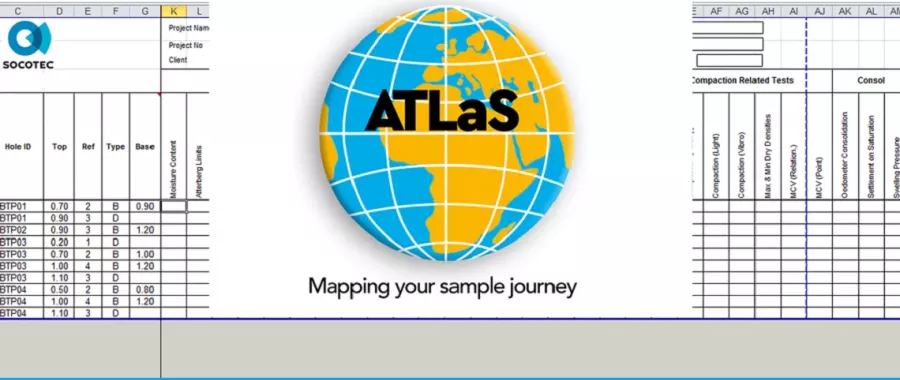Managing the supply of sample testing instructions to the laboratory has developed over the years.

SOCOTEC's new Assisted Testing Laboratory Schedule (ATLaS) provides an improved, more efficient way to communicate laboratory testing instructions. The tool comprises a vast array of key features, which include but are by no means limited to:
- Scheduling geotechnical and geoenvironmental/chemical tests in one handy location
- Creating test schedule data files for direct import to the laboratory information management system (LIMS)
- Creating a chain of custody and sample transmittal sheets
- Interacting with the schedule to ensure additional test-specific instruction requirements are entered, eg triaxial test pressures
- Avoiding the mismatching of sample references by interfacing directly with the sample source database
- Selecting specific samples for testing by hole, sample type or number
- Determining test types from a prepopulated list
- Adding customised lists of other test types (geotechnical and geoenvironmental)
- Tracking the progress of testing and changes to the schedule, eg restriction due to sample unsuitability
Development of digital scheduling systems
Managing the supply of sample testing instructions to the laboratory has developed over the years. Test scheduling was originally carried out by hand-written communication, at best using a pre-printed proforma/template. With the birth of the digital age, test requirements could be provided using a spreadsheet, which gave users some improved functionality. However, with data becoming more frequently sent in a digital format between teams responsible for different parts of ground investigation, the need to ensure continuity of common reference information became a major concern.
Since the late 1990s, ground investigation data has increasingly been used in the digital format developed by the Association of Geotechnical and Geoenvironmental Specialists (AGS), a non-profit industry organisation involved in many aspects of site investigation. The data format, currently in its fourth generation – AGS4.0.4 (2017) – provides a framework for the transfer of data between suppliers and users. Originally, this would be in the form of a data file submitted to the client alongside the final ground investigation report. However, thanks to increasing awareness and technological development, data transfer is now used daily to communicate information during all phases of ground investigation, both within and between the various organisations involved.
Field data – including borehole records, in-situ testing and monitoring – is captured using digital mobile devices such as SOCOTEC's Site Information Logging and Storage (SILAS) system, which sends data directly from sites to a central project database. Once generated on site and sent to the database, reference information for samples taken – including the project number, borehole number, type, depth and date – should never be re-entered into any other system. To do so is at best inefficient and runs the risk of transcription error and misrepresentation of the sample reference elsewhere. Details of the samples used for laboratory testing should always come from the original database and be retained within its data management system. This will allow test results to be slotted into the main project database, neatly aligning with the correct samples and all other relative data.
How does ATLaS operate?
While SOCOTEC has been using digital scheduling systems for some time, recent awareness surrounding the use of AGS4 as a means of providing testing instructions and receiving results meant that an update was required in order to make full use of current data management tools.
ATLaS operates in an Excel environment that is linked to the primary project database – in SOCOTEC’s case, Keynetix's HoleBASE SI. Selected holes and samples are loaded into the schedule template as required, with the individual tests indicated by determining the appropriate cell. This opens up a dialogue pane in which the requirements for the particular test are then prompted. Selecting an undrained triaxial test, for example, will request the test specimen diameter, single or multistage test, cell pressure(s) and dependent options if the sample proves to be unsuitable. Recompaction details for disturbed samples can also be entered here. Failure to provide the essential information to allow the lab to carry out the test will prevent the user from completing the scheduling of that test.
SOCOTEC can provide ATLaS in the form of an Excel spreadsheet prepopulated with sample information for the client to select testing requirements. Alternatively, for clients running their own database – containing source data provided directly from their investigation site, for example – they can populate with samples according to their own requirements.
Adopting a more versatile approach
Clients need not worry if tests are not listed in the schedule, as ATLaS allows the import of additional tests. These are compiled in a simple column of test names in an Excel format, which can be geotechnical or geoenvironmental. Once the testing requirements are completed, ATLaS generates an AGS4 file containing all of the project and sample information (AGS groups PROJ and SAMP) and testing requirements (LBSG and LBST). The file is then sent to the testing laboratory and imported into their LIMS (Laboratory Information Management System), providing them with everything they need to know to carry out the service. This can also be used by the organisation scheduling the testing as a record to track what tests have been scheduled on which samples. It should also be noted that ATLaS can create Sample Transmittal sheets and Chain of Custody documents, with the sample data file used with barcode scanning and other sample tracking systems.
As testing progresses, the results are entered into the lab's LIMS. At any stage, a set of results can be exported as an AGS4 data file. This includes the lab schedule groups LBSG and LBST, plus notes of any issues regarding insufficient suitable material. Provided they are operating on an AGS database, the client, designer or any other party working on the project can import the test data file and use the latest information to update their ground model, create plots of material parameters or measure the value of laboratory testing work carried out so far.
ATLaS represents a big step forward for SOCOTEC and the geotechnical investigation industry, as information can be obtained without taking up lengthy periods of time for validation and cross-checking. This provides laboratories with the opportunity to offer both efficient turnaround times and reliable data, which in turn allows the software to respond and deliver on increased client expectations.
Find out more about how SOCOTEC’s ground investigation team can deliver on your project requirements by following this link.
Want to find out more about SOCOTEC's geotechnical services?

You might also like







Add new comment